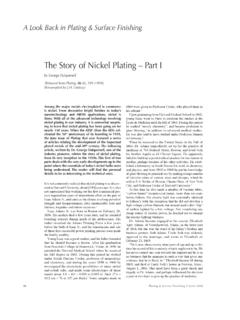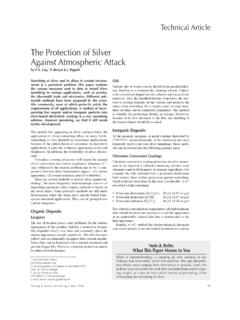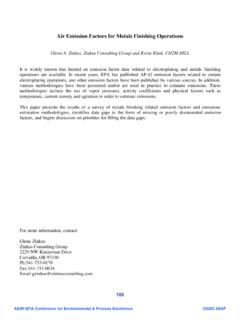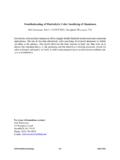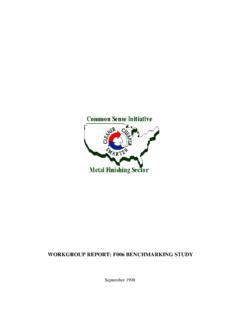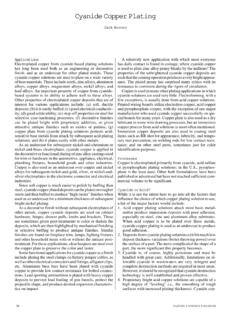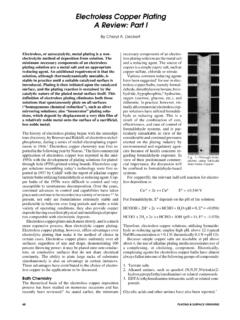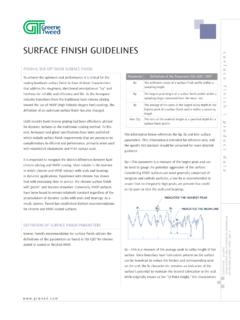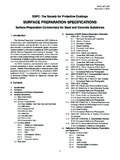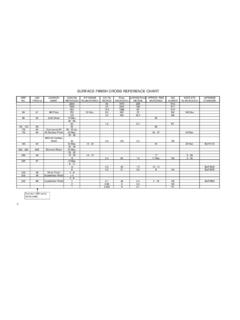Transcription of Surface Preparation of Metals Prior to Plating - …
1 Surface Preparation of Metals Prior to PlatingDr-Ing. N. V. Mandich, CEF, AESF FellowHBM Electrochemical & Engineering Bernice RoadLansing, Illinois 60438 ABSTRACTG enerally accepted as a critical step in most electroplating processes, Surface Preparation of metalsprior to the metal electroplating is presented. Definition of the clean Surface influence of basis metaland the choice of cleaning methods are discussed. Soak, spray, electrolytic, acid, solvent andultrasonic cleaning are elaborated as well as acid dip and pickling mechanisms of cleaning action are detailed, starting with the role of inorganic builders, throughsurfactants and solvent actions.
2 The basic surfactant chemistry will be discussed to provide theunderstanding of soil removal. The fundamentals of formulating science and know-how are fashionedfor different types of industrial formulations using a number of typical formulas as appropriateexamples. Because numerous papers and books are published on cleaning, an extensive referencesection and glossary is provided761 AESF SUR/FIN 2002 Proceedings AESFThe most important requirement in electroplating technology is cleanliness of the Surface to whichcoatings are applied.
3 In addition to the few insignificant exclusions, parts to be plated cannot beintroduced into an electroplating solution without pretreatment of some kind. The chemical andphysical nature of a metallic Surface has a very marked effect upon the quality of any electroplatedmetal that may be used to protect it. The presence of grease, oil, corrosion products, dirt, or otherextraneous material affects the adherence, continuity, and general durability of plated deposits.
4 Ingeneral, it may be said that the character of an electrodeposit is no better than the Surface to which it isapplied, and consequently it has come to be recognized that the production of protective, decorative orfunctional metal deposits of high quality is dependent upon the proper and thorough pretreatment ofthe Surface of the basis metal . This in turn requires proper equipment and operation frequently has been regarded as of minor importance and, as a result, this phase withina Plating operational sequence has received scant attention.
5 However, the ever-increasing severity ofcleaning specifications, the necessity of programming more closely-scheduled cleaning sequences, highlabor costs, and the tendency toward design of more complicated parts, and environmental issues haverapidly advanced metal cleaning from a guesswork procedure to that bordering to a cleaning is usually accomplished by six general methods of handling the work in relation to thecleaning media, namely: (a) soak tank, (b) electrocleaning tank, (c) spray washer, (d) solvent vapordegreaser (e) steam gun, and (f) abrasion with grit, shot blast or tumbling.
6 The two last-mentionedmethods may be omitted in present discussion since mechanical or out-of-the Plating line methods arenot considered. Interested readers can find details on those methods in reference books2, 3. Method d)has been discussed to some extent. The other three will be considered in detail DEFINITION OF CLEAN Surface In the Preparation of almost all Metals for decorative Plating , one of the most, if not the mostimportant consideration, is the preplating sequence: cleaning process.
7 This is so, because theappearance, adhesion and acceptance of the finished article depend primarily on a sound foundationfor the final finish, which is achieved only with an active and clean substrate. Clearly, only a properlydesigned preplating sequence will result in quality parts. It is not question of whether or not cleaningis required, but what type of cleaning should be can mean many different conditions to many people. Cleaning is loosely defined as the process ofremoving unwanted contaminants or dirt from a Surface .
8 A practical definition4 of word clean is containingno contaminants that would interfere with satisfactory deposition of one adhering finish . It is differentiatedINTRODUCTION762 AESF SUR/FIN 2002 Proceedings AESF from other finishing processes in that the cleaning process does not alter the Surface physically or properly cleaned Surface is just the same as it was Prior to cleaning, except for the missing soil5. Forexample, to the spray painter, clean can be simple freedom from oil or grease.
9 A plater will need to gofurther, in that his work must also be free of rust, scale, oxide and smut. A nickel-chromium decorativeplater would be especially more critical, since minor rust and scale would appear on finished parts as whitefrosty spots, pits, roughness or even black spots. A cyanide zinc plater may not be as critical, since less thanthoroughly clean parts would come acceptable, mostly because cyanides, inherently, are good cleanersbecause of their high alkalinity and ability to complex many metal conditions of clean and active Surface be achieved ion a reasonable, uncomplicated and costeffective manner?
10 For the plater, we can contentedly state that such a condition can be attained. Today,platers are taking parts, as they receive them, and are placing these parts through a cleaning processcycles in hand lines, hoist lines, automatic lines and strip lines with even more successful than everbefore. If we want to be successful in cleaning today, we must handle cleaning processes with the samecare and control as we do with Plating processes. The day of the single cleaner tank is gone cleaning systems must remove oil, grease, scale, rust and inert particles.
